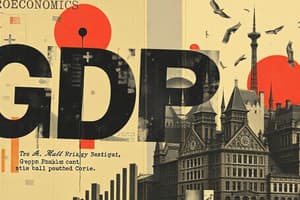Podcast
Questions and Answers
What does high unemployment percentage indicate?
What does high unemployment percentage indicate?
- A stable economy
- A sluggish economy (correct)
- A booming economy
- An inflationary economy
How do interest rates influence consumer behavior?
How do interest rates influence consumer behavior?
- They have no impact on consumer decisions
- They decrease consumer spending (correct)
- They increase consumer spending
- They stabilize the economy
Which government policy involves altering tax rates and public expenditures?
Which government policy involves altering tax rates and public expenditures?
- Trade policy
- Industrial policy
- Fiscal policy (correct)
- Monetary policy
What is the main goal of monetary policy?
What is the main goal of monetary policy?
What is the primary focus of macroeconomics?
What is the primary focus of macroeconomics?
What is the primary focus of macroeconomics?
What is the primary focus of macroeconomics?
How is Gross Domestic Product (GDP) defined?
How is Gross Domestic Product (GDP) defined?
What does high inflation lead to?
What does high inflation lead to?
What does unemployment refer to?
What does unemployment refer to?
Why is Gross Domestic Product (GDP) important in economics?
Why is Gross Domestic Product (GDP) important in economics?
Flashcards are hidden until you start studying
Study Notes
Understanding Macroeconomics
Macroeconomics is a branch of economics focused on large-scale patterns within entire economies instead of individual businesses or markets. It deals with broad themes like national income and employment levels rather than specific product prices or company profits. This field helps governments and policymakers better understand how economic conditions interact with each other and influence society's wellbeing.
The study of macroeconomics encompasses several key concepts and theories essential to understanding modern economies. We will delve into these ideas now.
Gross Domestic Product (GDP)
This measures the total monetary value of final goods and services produced by a country over a given period, typically one year. A higher GDP signifies increased production and economic growth, while lower numbers indicate stagnant or declining output.
Inflation
A measure of price changes across different products and services over time, inflation can reveal whether prices are rising too rapidly or remaining stable. High rates of inflation often lead to reduced purchasing power for individuals and may necessitate policy intervention or adjustments.
Unemployment
Unemployment refers to individuals unable to find work despite actively looking for it. Measured as the percentage of unemployed people relative to the labor force, high unemployment indicates a sluggish economy and requires concerted efforts from government agencies, such as job training programs or infrastructure investments.
Interest Rates
Interest rates refer to the cost of borrowing money expressed as a percent per unit of time, usually annually. They influence consumer spending and investment decisions as they represent the opportunity costs associated with using capital resources. Central banks manipulate interest rates to control inflation and stimulate economic activity when necessary.
Fiscal Policy
Fiscal policy involves the use of government revenues and expenditures to manage aggregate demand. By altering tax rates or public expenditure levels, fiscal policies aim to stabilize fluctuating economies and ensure sustainable growth.
Monetary Policy
Monetary policy entails controlling the nation's supply of money via various instruments under the authority of central banks. These tools help maintain price stability, foster economic development, and control inflation. For example, central banks might reduce interest rates during recessions to encourage more lending and boost consumption.
In summary, macroeconomics examines interrelated phenomena governing the overall health and performance of economies. With its consideration of structural factors influencing nations' wealth, this discipline empowers us to make informed choices regarding our collective economic future.
Studying That Suits You
Use AI to generate personalized quizzes and flashcards to suit your learning preferences.




